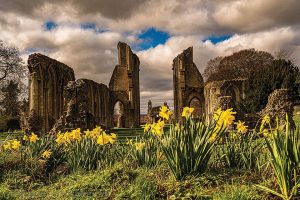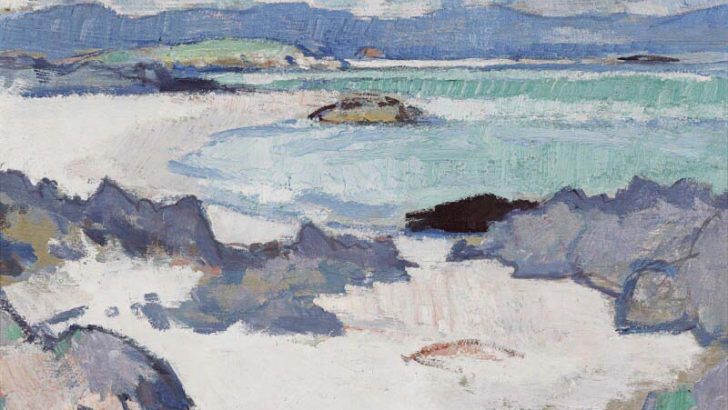Irish people desire most, it seems, to fly over Britain to reach Lourdes, Fatima, and Medjugorje. While well understanding their motives, I feel that by this choice they miss many interesting experiences, and narrowly restrict their contacts with places of faith over the past two millenniums, engaging places which in many ways have perhaps done more to sustain Christianity in Europe.
One of the regions they certainly neglect is Britain next door and the shrines and holy places of Scotland, Wales, and England. This week I want to briefly explore a small selection of these.
Iona
The name of this little Scottish island is well known of course, because of the connection with St Columcille, also known as Columba. But I suspect few enough people outside of Ulster visit it. But then how many people in the South make an effort to visit the Royal Irish Academy where they can see gratis in all its lonely, tourist-free, uncrowded glory, the early medieval manuscript connected with him, The Cathach or Battle Book of St Columcille.
The island itself requires a complicated journey to visit it. In the saint’s time it lay on the sea routes along the west coast of Europe which carried trade and culture back and forth along the extended sea board from Norway to North Africa for some four millennia – though for an Ulsterman like the saint it as merely a hop across the channel from Dál Riada.
Today one has to drive north from Glasgow to Oban, where the local ferry takes you across to Mull, and another long drive west though a desolate valley to reach Fionport.
From there a small ferry carries one across the channel to Iona. On a brilliant August day as I first saw it years ago the water was crystal clear thanks to the bright sun reflecting off the white sand of the sea bed. One felt one was in effect floating in the air and being carried over to some special place, as in a legend. It was a magical experience, if one can say that of a visit to a sacred Christian place.
The abbey buildings seen today are the result of modern restoration by a Church of Scotland group, but it is surrounded by the cemetery that holds the remains of some 62 kings, 48 Scottish, eight Norwegian, four Irish and two French. The saint’s grave lies nearby the abbey; but the place to see is the beach across the island where Columcille and his 12 followers landed, for there one can look out over a landscape almost unchanged since 563AD. Altogether one well worth the journey.

Walsingham
In stark contrast is the Shrine of Our Lady at Walsingham in Norfolk, which always seems to have visitors. It became a major place of pilgrimage after 1061 – before the Norman Conquest. According to the tradition, an Anglo-Saxon lady Richeldis de Faverches, was granted a vision of the Blessed Virgin, in which she was instructed to erect there a replica of the Holy House at Nazareth – making the place akin to Loretto. When first opened it housed a carved figure of Mary with the child Jesus on her lap (similar to those polychrome figures in our National Museum). Walsingham, previously merely a little village in rural Norfolk, became one of the country’s most important places of devotion, much visited today by pilgrims from Europe. And it remained important down to the Reformation.
This once famous place was quite neglected until 1922 when another Anglo-Catholic association revived it. It was recognised as the National Shrine of Our Lady by the English Catholic hierarchy too.
Today it also attracts a number of traditional-minded Roman Catholics, along with Orthodox and Methodist devotees. Visitors today can buy a little cast pilgrim’s badge, though at the moment I cannot find mine in the desk drawer where I keep such things.
It would be wise for those who dislike crowds to avoid August, and perhaps Easter, but May might be the right month to experience the special appeal of the place, with such strong echoes of medieval faith.
Glastonbury
Claiming roots much further back in time, Glastonbury holds a primacy of place as the earliest Christian survival in England which most scholars doubt. St Joseph of Arimathea, who came there, it is said, at some date in the 60s AD, bringing with him two small vials which carried the actual blood of Jesus. They have not survived, but it was also claimed that the oldest church in England built by the saint’s own hands stood there till it was destroyed in later times. It was made of simple wattle and clay daub, a detail which for many adds some credibility to the whole legend.
(Before believing all that you are told locally readers should consult R.F. Treharne’s critical work, The Glastonbury Legends (Cresset Press, 1967), or if you have access to a college library Dr J. Armitage Robinson’s Two Glastonbury Legends: King Arthur and Joseph of Arimathea (Cambridge University Press, 1926). From both of these books readers will learn about the origin, development and diffusion of the medieval hagiographical accounts.)
Today the town is the haunt of numerous New Age movements and shops, which will provide both amusement and information. It is indeed a place devoted to the value of beliefs of all kinds. But this is to overlook the fact that this small place in the West country was truly a place much visited in the middle ages, and which still preserves remains of some very moving Christian establishments, illustrating the long, lingering, but lasting nature of religious faith localised on such places.
As I say, I think it is strange that more Irish people do not visit places in England such as Westminster Abbey and Canterbury Cathedral (to which Dublin was so long subsidiary at the time of the Norman invasion).
The story of Westminster Abbey encompasses all the great movements in Christian life in England. It remains the place of all great state events, such as coronations, nowadays supervised by the Chief Marshal of England, the Duke of Norfolk, a Catholic.
The place is the last resting place of many of England’s great and good, not all of them even Christians by any means. In contrast, however, to the eclectic Europeanism of Iona, only 16 monarchs are buried here, rather less than Iona’s 62. Which seems to suggest that in the eyes of the Catholic middle ages Iona was the more important place.
However one of these is St Edward the Confessor, whose tomb is the most magnificent aspect of the Abbey. But there are those who might say that the massacre of the cheering Saxon crowds by the troops of William the Conqueror at his coronation very effectively symbolises the often tyrannical rule from the English throne.
St Thomas Becket’s tomb in Canterbury Cathedral
St Edmund was a confessor, he did not suffer martyrdom. St Thomas of Becket was a true martyr, struck down on the altar of his Cathedral by three knights on a mission to please Henry II, the effective conqueror of Ireland.
His tomb became the largest and most significant shrine for the ordinary people of England and for many others too across Europe. The nature of the pilgrimage has been itself enshrined in Geoffrey Chaucer’s great epic The Canterbury Tales which began to circulate around 1400. The shrine too is the setting for Eliot’s verse drama Murder in the Cathedral.
It has to be admitted that the cathedral is undoubtedly one of England most important visitor sights, along with Windsor Castle. However, Evensong on a summer evening is a lightly attended event and a very moving ceremony properly reminding all visors that the place is not an amusement park, but is indeed a place of ancient faith which still finds expression there.
The London Oratory
Though created by the Oratorian Order of St Philip Neri, the London Oratory owes its origin, not to St John Henry Newman, but to funding by the many followers and admirers of the writer and preacher Fr Frederick Faber in 1852.
The Oratory is renowned for its music, and it has also maintained a regular Latin Mass. But in some ways it echoes Iona. Columcille was a missionary priest attempting to bring the Gospel to the pagans of a Northern European wilderness. Newman’s life was devoted to defending and maintaining that faith in an age where the wilderness had become an intellectual one. Perhaps for some travellers this might not be the place to end a British pilgrimage, but the place to begin, ending rather at Iona, where perhaps the nature of faith in creation can be better experienced.


 Peter Costello
Peter Costello
